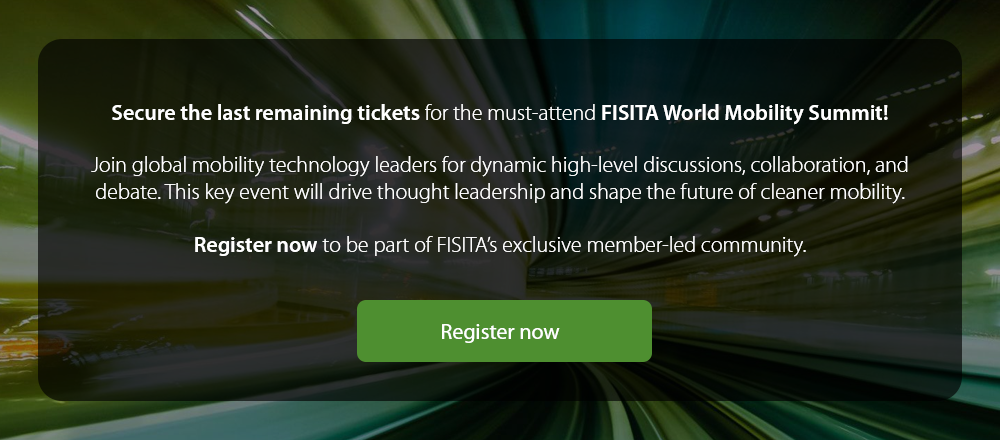FISITA World Mobility Summit speaker Nico Cuevas shares his thoughts on the topic of the event’s title, “To EV, or not to EV?”
Nico Cuevas is the CEO of Urbix, a US developer of graphite processing technology which focuses on natural battery-grade graphite using environmentally friendly refinement processes.
Founded in 2014, Urbix has operations in Mesa, Arizona and Research Triangle Park, North Carolina. In September 2024, the U.S. Department of Energy selected Urbix to enter into award negotiation for US$125m of funding to advance the construction of its commercial-scale graphite processing facility.
In the build-up to the 2024 FISITA World Mobility Summit, we spoke to Nico and asked him to share some thoughts on the event’s topic, “To EV, or not to EV?”
What are the key challenges for the automotive industry in the transition to clean mobility, and how could these be overcome?
Driving down costs, continued innovation, and expanding product options for EVs is a key to broader adoption. One of the most significant challenges is the cost of EVs, largely driven by the cost of battery manufacturing. Batteries make up a substantial portion of an EV’s overall cost, and the materials required are expensive and subject to market fluctuations. Battery performance and cost go hand in hand; for broader EV adoption, manufacturers need to offer high-performing batteries at a price point consumers are willing to pay. Urbix is addressing this challenge head on by developing a unique processing method to produce battery grade graphite here in the US at a competitive price and without any ‘foreign entity of concern’ or FEOC dependencies.
Sales of battery electric vehicles are slower than initially hoped and expected, but the products themselves are highly compelling. What has impressed you most about the evolution of BEVs?
The innovation and creativity in the industry is truly exciting. I’ve been most impressed by the ability to scale-up new technologies that will address immediate and long-term needs by acting as drop-in alternatives that leave room for innovation within conventional chemistries. Paired with the more long-term breakthrough technologies for the late 2030s, this should inspire consumer imagination, and excitement is reason for confidence in the future of industry.
We’re seeing regional and national governments introduce restrictions or bans on the sales of internal combustion engine vehicles after certain dates. Is this the right approach, or should market forces lead the transition to clean mobility?
No, I don’t think bans are the right approach. I expect there to be a role for internal combustion engines for a long time to come and I respect individual choice. Plus, there is a reason why this is called an energy transition. I think it is better for governments to incentivise innovation and adoption of technologies, such as EVs, that are better for the environment and the consumer. I believe a combination of targeted incentives and market forces will motivate broader adoption of EVs. Give the consumer a reason to buy an EV, don’t force them.
Electrification appears to be inevitable, but few automakers can compete by producing BEV only, and BEV is not suitable for all markets, in terms of cost, infrastructure, terrain… How will the transition play out?
I’ll refer to my earlier answer: a blend of transportation options will and should be available. There will not be one powertrain technology to rule them all. There is just not enough global capacity to produce battery materials fast enough for one type of vehicle chemistry.
Urbix focuses on natural battery-grade graphite using environmentally-friendly refinement processes. You’ve even talked about looking forward to a time when we no longer need graphite in EV batteries. What, then, is your take on the automotive industry’s management of natural resources for the transition to clean mobility?
Graphite is likely to be the dominant anode material for the foreseeable future and battery manufacturers are currently investing in manufacturing facilities based on this assumption. Full adoption of batteries that don’t require graphite are perhaps decades away and require considerable innovation. Urbix will continue to evaluate opportunities to leverage our unique processing technology for a variety of critical minerals. However, our primary focus for now is on graphite. As mentioned before, the intent for Urbix is to continue to innovate and evolve along with the market needs and demands. And yes, at some point this would entail a transition out of the conventional chemistries. I envision us continuing to build these future innovative products.
You’re speaking at the FISITA World Mobility Summit in November 2024. The event is titled, ‘To EV, or not to EV?’ With that in mind, what will be your key message to delegates?
The message to everyone will be: If you want to be Kodak, don’t EV. I’ll take the alternative.
